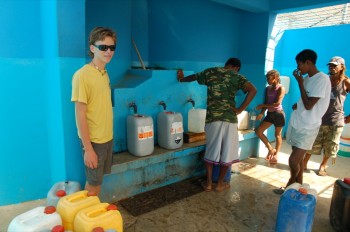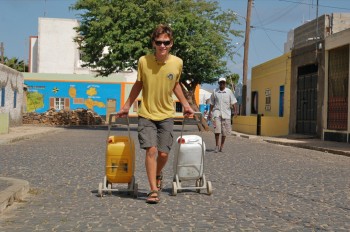Cape Verde – Sal – Palmeira
Cruising notes given in good faith, but not to be taken as gospel.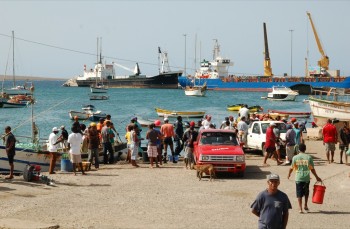
Palmeira is the port of entry for the island of Sal and is also one of only three places where yachtsmen can clear in and out of the country. It is situated on the west coast and, being the only settlement in the vicinity, is easily spotted in reasonable visibility.
This article begins with a discussion of the place and its history. For information relating to navigation and anchoring, scroll towards the bottom of the page.
First Impressions
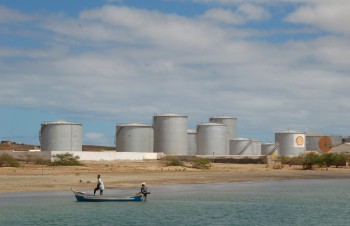
Most people don’t think much of Palmeira. For many yachtsmen this is their first foray away from the Western world, and they arrive in a state of anticipation. To be sure, the island has already let them down – it is low and brown and really rather ugly; and the wind in the immediate vicinity is unnecessarily vigorous. The sky is hazy, and the weather is not as hot as it ought to be; but around that corner… surely the anchorage itself will be the stuff of dreams?
Rounding the end of the sea wall our first-timers enter the harbour – but instead of the picture postcard setting they find themselves in a very drab little bay. The shoreline upwind is dominated by a series of large, silver-painted gas tanks, and the village looks scruffy without being rustic or picturesque.
This is not what you had in mind when you turned your back on traffic fumes, tarmac, and supermarket car parks. When you set off into the wide blue yonder you thought that paradise was a palm-fringed beach complete with turquoise waters, surf-shack beach bars, and snorkelling on a coral reef.
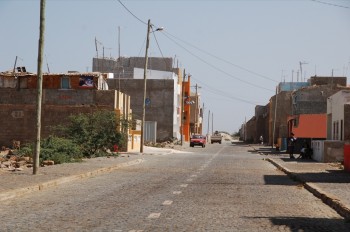
Yes, we all like that sort of thing… but some of us like a bit of rough to go with the smooth.
If Paradise Beach is the only thing that you want from the cruising life, go straight to the Caribbean; do not bother with the Cape Verdes. In particular, do not bother with Palmeira.
If, on the other hand, you also want to meet the other half and see how they live, stick around.
You can’t Judge a Book by its Cover
Most folks come to Palmeira expressly for the purpose of clearing in to the Cape Verdes. They stay here just long enough to recover from a week of interrupted sleep, and then they push on. Sal is the least inspiring of all the Cape Verdes and at first glance there seems to be nothing and no one here worth knowing – but once you get to know it Palmeira is really rather a special place.
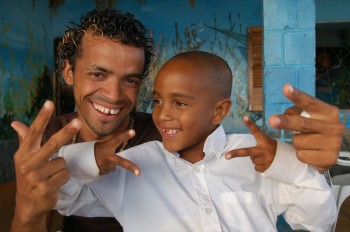
There’s nothing beautiful about the scenery, it’s true, but the people of Palmeira are, for the most part, very honest and perfectly friendly. If they’re not as friendly as they used to be 17 years ago, when we first came here, that’s simply because familiarity breeds contempt. Back in those days yotties were pretty much the only tourists that these folks ever saw and even yotties were few and far between; so we were a big hit.
Now there is a constant stream of yachts coming and going, and a handful spend months at a time anchored here. We’re no longer a novelty – they no longer welcome us ashore with smiles and the offer of grog, and the kids no longer follow us around as if we had a pipe and were leading them along – but if you make the first move and begin chatting to them, then you will find that the Palmeirans are just as good-hearted as ever they used to be.
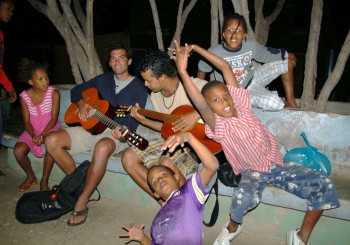
If you stand back and watch them as they interact with one another then you will soon notice that this little village is rather different from any modern European community. The place has grown a great deal in the past 15 years, but still everybody here knows everybody else intimately. Watching them, on a Sunday night, dancing in their rustic night-club is a bit like watching a class full of nine year olds. Not that the villagers’ behaviour is at all immature; it’s just that they behave with a complete lack of self-consciousness and they are absolutely accepting of one another.
They all dance the traditional “coladeira” in a most intimate manner, with their thighs rubbing. And they don’t just dance with their own partner; they dance with whoever comes along. Everyone smiles pretty much all the while. Altercations are very few and very, very brief. The village idiot – making obscene gestures that he evidently doesn’t understand – is cuddled fondly by each woman in turn. No one considers him to be an embarrassment; they’ve known him since his birth.
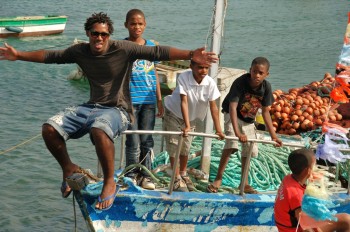
Of course, this easy familiarity is not unique to Palmeira. The same ambience is found in the mountain villages in the other islands. Somehow one expects it there; it comes as no surprise to find that all of the people of a relatively isolated settlement are all related to one another and know every last detail of each other’s lives. But Palmeira is poised on the edge of the modern world – our world – and it is easy to overlook the fact that it is really just a fishing village. It comes as quite a shock to realise that in this place you cannot live as we habitually do, and stand aloof and apart. In Palmeira every man knows his neighbour’s strengths and weaknesses; he knows who they’ve slept with, and whether they were any good; he knows their likes and dislikes, their religious persuasions, their perversions, their little foibles, their shoe size, their bra size, and the size of their purse.
I guess this is how it used to be throughout the whole world, before communities became too large and before we grew footloose.
Village Life
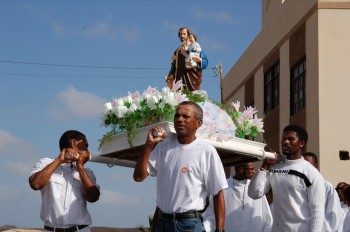
Palmeira began life as a fisherman’s village, and so far as most of the residents are concerned that’s what it is still. The commercial port spreads all around them, like an invasive weed; and the bay becomes increasingly crowded, with foreign yotties arriving all the time to squeeze themselves in amongst the charter yachts, the derelict hulls, and the villager’s own little boats. Shore-based tourists arrive by the bus-load, like sheep, and are carted out to the charter boats to be fleeced; but throughout all of this the local people just get on with what they’ve always done. Early in the morning, before the sun is up, they head out to sea and fish. At ten or eleven they bring home their catch and gut them on the quay; or else, if they’ve brought in a fat tuna or a boatload of cavalha, they argue over the price. When the day’s work is done they go home to eat a meal of cachupa, or they play yuri (warri) on the quayside, or – if they managed to get a good price for their fish – they settle themselves down to get drunk. And they are happy with their lot.
The Port

30 years ago a fishing village is all that there was in Palmeira. The men kept their boats on the beach and gutted their fish on nearby. There was no protective seawall. The bay was wide open to the swells, and the ships which came here to unload barrels of aviation fuel had to put out anchors and moor to huge bollards set into the beach. The inter-island ferry also moored in this way, and the fishermen earned themselves some pocket money disembarking the passengers.
The mooring bollards are still there (in front of the big silver gas tanks) but nowadays nobody uses them. Nowadays the fuel tankers moor to large buoys lying just outside the port – unlit buoys, you may care to note… – and the fuel comes ashore via a pipe.
Having arrived on terra-firma the fuel pipe runs directly from the gas depot to the airport, and if you should happen to want to walk to Espargos this is the shortest route.
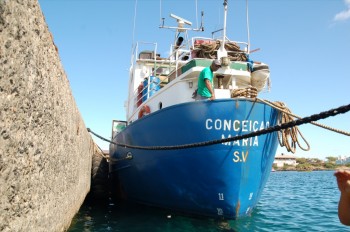
At about the same time that the pipe was installed a seawall was also built. It was not big enough to accommodate the tankers but it provided a berth for the inter-island ferry and for various small cargo ships. 17 years ago there were half a dozen ships plying the islands and none of them was more than 200 feet long.
Now… Now only one of those old coasters is still in use, and it is dwarfed by the newer cargo ships and ferries. The old wall is not really big enough to cope with such vessels and so in 2010 it was extended.
This is good news for yotties.
Were it not for the seawall the bay would be open to the swells which often roll in from the north during the winter months. The construction of that first wall changed an open roadstead into a decent anchorage – but a fairly small one. In the old days, when there were never more than three yachts here, we could easily hide behind the little wall. But now there are never fewer than 15 yachts, it seems. Thus the extension to the wall is of great benefit to us.
However… (A Word of Warning)
As I say, there are never more than 15 yachts here nowadays; and sometimes there are as many as forty.
Now, you cannot fit forty boats behind the wall. Thus, in the peak season many visitors still find themselves having to anchor outside the sheltered area. In the winter, when the swells roll down from storms in the northern latitudes, the area not shielded by the wall is sometimes exposed to huge rollers and in these conditions the boats surge to and fro on their chains like… well, like nothing I’ve ever seen before, actually! To be anchored like that is not safe! And the fact that a dozen other people may be doing it does not make it any better.
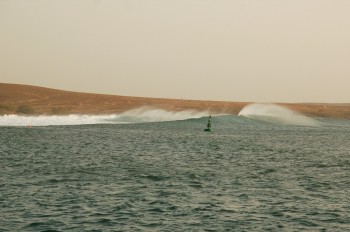
If you can’t find room behind the wall and the swells get up, you need to get out. If you haven’t cleared into the country then we would suggest that you moor to the wall for the time being. Anything rather than leave your boat exposed to this peril.
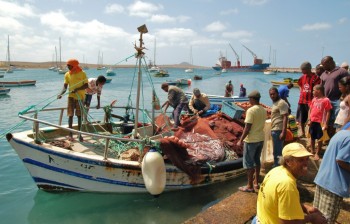
For that matter, when the swells are up one also needs to take great care whilst entering or leaving the port. On the occasion of our last visit (in the month of February) we had just arrived and had anchored when, glancing back, we saw a huge standing wave go sweeping past the wall and across the whole bay. This was followed by another of the same stature – a breaking wave two metres high, which extended all the way from the wall to the shore; and then all was peace and happiness again.
Now we know why the local fishermen always take this stretch of their journey flat out!
Figuring on Biggering
Having extended the old seawall the Cape Verdeans – under the direction of expert European contractors – have now begun work on the construction of an even bigger outer wall which will provide berthing for the fuel tanker and also for ocean-going cargo ships and cruise ships.
If I were making a cruise aboard a fancy ship I’d be less than impressed when it put into a crummy little port on an island with no sites of cultural interest and nothing pleasing to the eye… but cruise ships do occasionally stop here and at the moment they have to anchor off and unload their cattle using the ship’s boats.
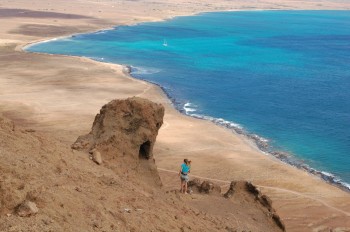
As for the cargo ships – they are going to bring in the materials which will enable European developers to carpet the barren brown coastline with housing for 400,000 holiday-makers.
It’s all been approved. All they need now is 100,000 people with more money than sense.
Navigational Info
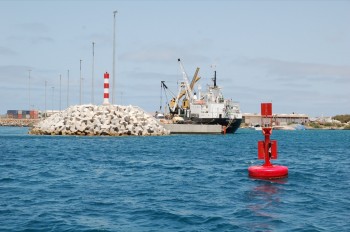
The port is now well-buoyed and the buoys are well-lit. All the same, I would be a bit wary about coming in here in the dark, particularly if there is a swell running.
Seven years ago there was a large fishing boat lying wrecked in the entrance. It was just below the surface, and it was unlit. It’s gone now, but there are two other wrecks in the harbour; and it’s the sort of thing that could easily happen again…
Speaking of wrecks – there’s one in the anchorage. It lies immediately north of the large starboard hand (green) buoy which marks the outer limit of the anchorage. (You may not anchor between the buoy and the quay; this space is needed by the cargo ships, which sometimes have a lot of difficulty getting themselves off the wall when the wind is blowing hard.)
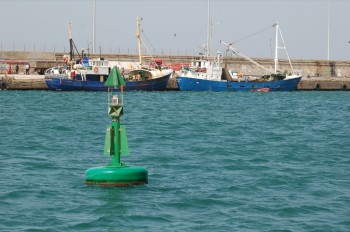
The wreck is about 50ft long and the for’ard end is about two and a half metres below the surface. It’s very rusty. Whatever it is, it’s been down there for a good many years.
Unwitting of the existence of this hazard, in 2010 we dropped our anchor right inside the wreck… and Caesar then had to spend half an hour in his scuba gear getting it back again.
We subsequently marked the wreck with a buoy, but the buoy evidently proved too attractive… It has been replaced by a small plastic oil can. The can is tied onto the bowsprit, and the wreck extends from here towards the starboard-hand navigational mark.
Dinghy Docking
Visitors may moor their dinghies on the shoreward corner of the fishermen’s quay, well out of the way of the fishing boats which come and go all throughout the day. (There are also public showers in the vicinity of the quay, and these too are available for the use of visiting yotties.)
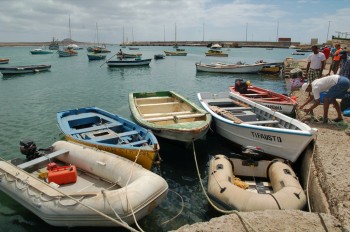
If you don’t want to make use of the crowded little quay then you can land on the beach and carry the dinghy ashore – but don’t do as some silly so-and-so did a couple of years back, and lock your dinghy to one of the fishing boats lying on the beach.
Perhaps he thought that the boat was abandoned… In any event, when he came back from Espargos the boat had gone, and so had his dinghy.
(The fisherman was quite apologetic – and quite amused, too – but he did have to go and earn his daily crust, so the dinghy went fishing too, for the day!)
Internet
At the time of writing there is no wifi in the anchorage but there is at least one internet cafe in the village.
There are cheaper, better internet facilities in Espargos; and Espargos is only a 50 cent bus ride away.
Shopping and Banking
There are several very small grocers and one small supermarket in the village. Prices here are much the same as in Espargos, but if you want to buy vegetables you do better to go into town and buy them in the market.
The nearest bank is also in Espargos. The shopkeepers in Palmeira will take Euros, but they won’t give you a very good rate.
The village shops also serve as bars. They are still open at nine or ten o’clock at night, but by this time the counter will be lined with half-sozzled fishermen knocking back the local rum, or “grogue”. If you want to sample some of this local elixir take along an old mineral water bottle and buy it by the litre. If you buy it from the souvenir shops, in a bottle with a pretty label, you’ll pay more than twice as much.
Gas
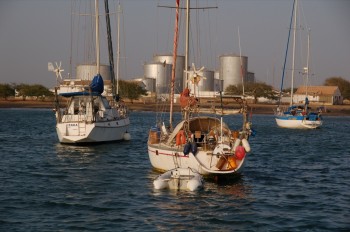
Back in the old days the folks at the gas depot, on the beach ahead of the anchorage, were perfectly happy to refill any sort of bottle provided you took along your own adaptor. Now, they are a wee bit fussier: they will only fill non-regulation Cape Verde gas bottles via the adaptor belonging to a German expatriate – one Carlos, as they know him – who is resident in the village.
And Carlos’s adaptor only fits French bottles.
So, if you want to fill any other sort of bottle then you need to borrow the sacred adaptor, borrow a French bottle, take both to the depot on the beach and then – having got hold of the gas – tip it into your own bottle via your own system of adaptors.
Water
Water is available from a stand-pipe on the far side of the road which bisects the village; or, if you don’t fancy lugging jerry cans to and fro, you can go alongside and have a ton of water delivered by tanker.
Crime (see Cape Verde Security)
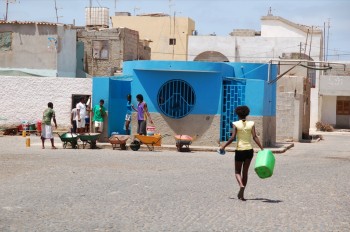
Unfortunately there is a very small handful of bad guys amongst the Palmeiran villagers and – sad to say – they are the ones who are most likely to want to attach themselves to the itinerant yotty. These young men come knocking on the side of the boat, full of smiles and advice, and if you are the sort of person who likes to feel that you have integrated with the locals then you might feel inclined to pump the out-stretched hand and respond warmly to all the “Ca va? Toot dret? Howya doin’ buddy?”
At least two of these guys are good fellows; but at least one is a crack-head and a criminal.
In January of 2010 a friend was walking on the beach with a group of boat-boys and other young men whom he considered to be his mates when one of them knocked him down. His pockets were rifled and his mobile phone was stolen. The phone was a fancy waterproof one, but – more importantly so far as our friend was concerned – it contained all of his business contacts. Instead of going to the police – which we urged him to do – he offered a reward for the return of the SIM card. In other words, he let the crook keep the phone, and he paid him a little bit extra too!
Believe it or not, the police force in Sal is very efficient. The local people don’t want their island to have a bad reputation and they will be as eager as you to resolve the problem.
- When a watch was stolen from our boat, the local police got it back.
- When a young couple had their lap-top stolen while their backs were turned, in a village bar, the police got it back for them.
- When some French friends had their boat gutted of all their belongings (after they left it unlocked) the police got them back – eventually.
The police have only to put out the word and the goods will eventually be returned. However, the criminal will not be punished because – inevitably – he is the sergeant’s sister’s husband’s cousin’s nephew.
Boat-boys
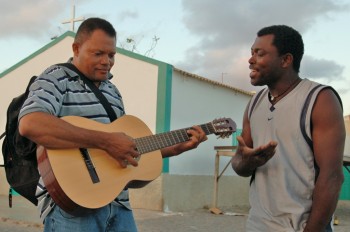
Don’t get me wrong; the boat-boys are not all tarred with the same brush.
Paul, for instance, is a drinker – but then so are many yotties! He isn’t a thief, and he isn’t a junky, and many people like him a lot and have had a lot of fun in his company. One French friend of ours rated Paul the best mate he’d made in all of his travels!
Zeedan is another reliable and trustworthy fellow. He hails from Sao Nicolau where he has his own lateen-rigged fishing boat; so he understands boats and the sea. He’ll happily clean your hull or paint your deck, or he’ll run to and fro with a wheelbarrow filling your jerrycans from the village stand-pipe. Zeedan speaks fluent French.
Engineering and Chandlery
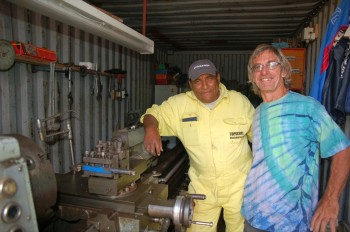 If you need epoxy paint or fibreglass, or if you need engineering work, don’t go to the boat-boys. Go to Manuel Monteiro.
If you need epoxy paint or fibreglass, or if you need engineering work, don’t go to the boat-boys. Go to Manuel Monteiro.
Manuel used to be an engineer in the merchant navy. He now runs a small cargo ship of his own, sending her hither and thither amongst the islands. While the ship is away he amuses himself by restoring old fishing boats, and he has a small machine-shop (housed in a container) on the edge of the port.
We first met Manuel 17 years ago and have kept in touch ever since. He is not fast… but his work is very reliable. He speaks fairly good English.
For more information about the Cape Verde islands, take a look at our other recent articles about the archipelago:
- General info:
- Sal
- São Vicente
- Boa Vista

